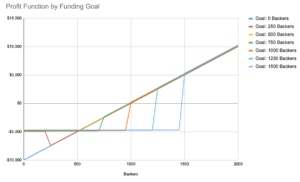There’s Something I Never Considered
A while back, faithful Fleen follower Mark V pointed me to a series of Kickstarter things that he thought I might find interesting. It’s not a [web]comic Kickstarter, it’s a game Kickstarter, but there’s a webcomic connection — the creator (by name of Michael Prescott) sprinkled a comic through the campaign updates to demonstrate aspects of the game, which I thought was a clever idea (start with Update #3 and work your way forward; not all updates have comic entries).
There was also a lessons learned post from the start of 2020, the sort of thing you’d find from a posting or conference presentation by your Spikes, your Lasers Webber, or Bradleys Guigar. Good solid advice, but the sort of thing you might find in other channels.
But the real meat of Mr V’s pointers was a posting from this month on Kickstarter math that was presumed to my cup of tea — you were right on that one, Mark; I love this stuff — and inside was an argument that I’ve never seen made around Kickstarter campaigns. It’s probably more common in the [baord]game space than the [web]comics space, as it involves sunk costs in a way that doesn’t necessarily come up in webcomics, but I still wanted to talk about it.
The way everybody thinks of Kickstarts is How much money do I need to make it to break-even, and preferably profit?. You’ve got a project that will cost (summarizing here) US$10,000 of your time to make, with a unit price of US$30 (what the backer pays), a unit cost of US$20 (what it costs you to produce and ship), and a margin of US$10. The break even point is 1000 orders — US$30,000 raised, US$20,000 in your costs, US$10,000 left over that offsets the US$10,000 of your time, meaning a total profit of zero. Order number 1001 and every order after nets you ten bucks.
Simple. Everybody does these calculations. The goal is US$30,000 or more; any less, you don’t make the thing because you’ll lose money.
But this example does something unique. What if you’ve already put in US$5000 of time in figuring out the Kickstarter, and know that once it goes up you’ll have to spend another US$5000 worth of time to finish your design. Where do you set the pricing? The simple answer is US$30K like before, but there’s a more complex answer:
You’ve already put in that US$5K of work; if you fail to fund at US$30K, you’re not zero in the hole, you’re at a US$5K loss. It may be possible to set the goal lower so that you do the project and yes, lose money, but lose less than if it doesn’t fund.
Let’s say you can’t get 1000 orders, but you can get 800; that’s US$24K and US$10K in your time, US$16K in production costs, a total of US$26K so you lost two grand. That’s a disaster! But if you don’t fund, if you never do the project at all, you’re out five grand. It’s a loss, but it’s better than holding out for break even. Prescott’s argument is that you shouldn’t set the Kickstarter to compensate all costs, but rather to compensate the sunk costs before you launch the campaign. You might not make a profit, but you won’t be any worse off than if you didn’t do anything.
The reason that this doesn’t necessarily map one-to-one to [web]comics Kickstarts is that the sunk costs aren’t going to occur in the same way — most creators don’t make a comic every day for a year in preparation to launch a Kickstarter to print it and get nothing in return; they did that because they were updating their site, selling ads or other merch, and the print run is a secondary sale of what they’ve already been paid for. By contrast, the game space can demand significant, project-specific work to get to a point where you can determine if the project is viable going forward (say, a demo to gauge interest or practicality).
If you’re not making money on the pre-campaign work, you probably need to do a campaign that’s specifically designed to pay you to make the comic and pay for physical production (not many creators have the track record to support that kind of prepay). Either that, or consider that your real goal needs to not just pay for the print run, but to compensate you for the work you’ve already done in which case, yeah — consider the reduced-loss target for funding rather than full break even.
Anyway, this is a very short summary of Prescott’s points, which I find well-presented and persuasive. Give them a read before you do your next Kickstarter plan, and thanks to Mark V for pointing me towards the analysis.
Spam of the day:
It is with sad regret to inform you [nope] is shutting down. Any group of databases listed below is $49 or $149 for all 16 databases in this one time offer. LinkedIn Database, USA B2B Companies Database, Forex South Africa, Forex Australia, Forex UK [that’s enough of that]
So you collected a metric squatload of email addresses and account names and want me to buy them so I can spam them? Can’t imagine why people don’t want to do business with you.

The above comments are owned by whoever posted them. The staff of Fleen are not responsible for them in any way.